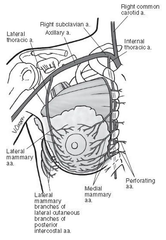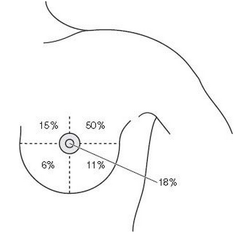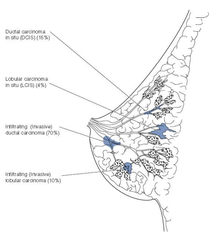Benign Breast Disease and Breast Cancer – Flashcards
Unlock all answers in this set
Unlock answersquestion
Quadrants of the breast
answer
Upper outer quadrant, lower outer quadrant, upper inner quadrant, lower inner quadrant
question
major blood supply to the breast

answer
internal and lateral thoracic arteries
question
lymph nodes responsible for draining a majority of the breast
answer
axillary lymph node (97%) - remaining 3% is by internal mammary nodes
question
Nerves at risk of damage during surgical breast dissection
answer
- intercostobrachial nerve (sensation to upper medial arm) - long thoracic nerve (serratus anterior muscle) - thoracodorsal nerve (latissimus dorsi muscle) - lateral pectoral nerve (pectoralis major and minor muscles)
question
Estrogen effect on breasts
answer
ductal development and fat deposition
question
Progesterone effect on breasts
answer
promote the lobular alveolar (stromal) development that makes lactation possible
question
breast changes in postmenopausal women
answer
tissue atrophy, loss of stroma, and replacement of atrophied lobules with fatty tissue
question
3 major components of breast cancer screening of women at average risk
answer
- clinical breast examination - breast self- examination - screening mammography
question
At what age should clinical breast examination be done annually?
answer
40 - before then its every 1-3 years
question
ACS guidelines for screening mammograms
answer
annual mammograms starting at age 40
question
Women at high risk for breast cancer
answer
- those who have BRCA1 or BRCA2 mutation or a first degree relative w/ either mutation - those who underwent radiation to the chest b/w the ages of 10-30 - those who have a hereditary syndrome associated w/ multiple cancer diagnoses
question
Women at moderate risk for breast cancer
answer
- those w/ a personal hx of breast cancer or its precursor lesions - those who have particularly dense breast tissue on mammogram
question
Screening recommendations for women at high and moderate risk for breast cancer
answer
- teach breast self- awareness - clinical breast exam q 6-12 months - annual mammography starting at age 25 or 5-10 years before the age of the youngest cancer diagnosis - interval breast MRIs is also a possibility
question
Better imaging modality compared to film mammography in women w/ dense breasts, women younger than 50, and premenopausal or perimenopausal women
answer
digital mammography
question
Clinicians should assess breast pain by asking about what type of features?
answer
- cyclic or noncyclic - bilateral or unilateral - diffuse or focal - associated sx (back/neck pain, erythema, fever) - use of medications (OCPs and HRT) - any hx of trauma, radiation or surgery to the breas, famhx, constitutional sx (e.g. weight loss or gan)
question
FDA approved medication for mastalgia
answer
danazol
question
characteristics of a nipple discharge that is most concerning for malignancy
answer
- spontaneous (ie not w/ manual expression) - bloody or serosanguineous - unilateral - persistent - from a single duct - associated w/ a mass
question
most common cause of bloody nipple discharge
answer
intraductal papilloma
question
Physical examination to evaluate nipple discharge complaint should include
answer
looking for: - skin changes - associated masses or lymphadenopathy attempt to elicit secretion by applying pressure to base of the areola
question
bloody or serosanguineous nippular discharge should be tested on a
answer
guaiac card and sent for cytologic evaluation
question
Women w/ nipple d/c, amenorrhea, menstrual irregularities, headaches, or visual disturbances should have there _____ and ____ levels drawn
answer
prolactin and thyroid
question
women w/nippular d/c w/ associated masses should have
answer
ultrasound and/or mammography evaluation
question
What percentage of new breast cancers are not seen or detected via mammography?
answer
10-15%
question
Most common causes of breast masses
answer
fibroadenomas and breast cysts
question
When a breast mass is being evaluated, it is important to ascertain
answer
- manner in which it was discovered - associated tenderness or trauma - relationship of changes to the menstrual cycle - location, size, shape, consistency, and mobility - overlying skin changes
question
Malignant breast masses are usually characterized as
answer
single, firm, nontender, and immobile w/ irregular borders
question
Characteristics of a lymph node that make it worrisome
answer
- >1cm - fixed - irregular - firm - multiple
question
Collaborative scoring system for breast masses is called
answer
BI-RADS: Breast imaging reporting and database system
question
Imaging evaulation for a breast mass found in a woman <30 years
answer
u/s
question
imaging evaluation for a breast mass found in a woman >/=30 years
answer
mammogram
question
A breast cyst should be excised if
answer
- fluid is bloody - mass persists after fluid is removed - cyst is persistent after 2 aspirations - fluid reaccumulates w/in 2 weeks
question
In a woman <30 years old with a palpable solid mass, what is the primary method of choice for sampling tissue?
answer
fine needle aspiration - if this fails, then excisional biopsy is attempted
question
In a woman >/= 30 with a palpable solid mass, what is the primary method of choice for sampling tissue?
answer
core- needle biopsy
question
If a nonpalpable lesion is found on mammography, what is the next step?
answer
excisional biopsy under needle or wire guidance - all the abnormal tissue should be excised along w/ a 1-cm rim of normal tissue
question
Fibrocystic breast changes is due to
answer
exaggerated stromal response to hormones and growth factors
question
typical presentation of fibrocystic breast change
answer
- painful breast masses - multiple and bilateral
question
Peak incidence of fibrocystic breast change is seen in women ages
answer
30-40
question
When is pain associated w/ fibrocystic change worse?
answer
during the premenstrual part of the cycle
question
treatment of fibrocystic breast change
answer
pain is ameliorated w/ reduction of caffeine, tea, and chocolate avoid trauma and wear support bra evening primrose, vit E and B6, danazol, progestins, bromocriptine, and tamoxifen
question
Fibroadenoma def
answer
benign tumors w/ glandular and stromal components
question
most common benign tumors of the breast
answer
fibroadenomas
question
P/E findings of a breast fibroadenoma
answer
round, well- circumscribed, mobile, firm lesions that are rubbery and nontender
question
cystosarcoma phyllodes def
answer
rare variant of fibroadenoma that involves epithelial and stromal proliferation. Can be benign or malignant
question
preferred method of diagnosis for cystosarcoma phyllodes
answer
core needle biopsy
question
treatment for cystosarcoma phyllodes
answer
wide local excision w/a 1 cm margin for small tumors; mastectomy for large lesions not amenable to wide local excision
question
P/E finding of cystosarcoma phyllodes
answer
large, bulky, mobile mass that is painless overlying skin is warm, erythematous, shiny, and engorged.
question
Intraductal papilloma def
answer
benign solitary lesion that involves the epithelial lining of lactiferous ducts
question
How are intraductal papillomas identified?
answer
open involved duct to visualize the tumor
question
treatment for intraductal papilloma
answer
excision of the involved ducts after localization by physical examination and core needle biopsy
question
mammary duct ectasia aka
answer
plasma cell mastitis
question
mammary duct ectasia def
answer
subacute inflammation and fibrosis of the ductal system causes dilated mammary ducts; there is also concurrent infiltration of plasma cells and significant periductal inflammation
question
When during a woman's life is mammary duct ectasia most likely to occur?
answer
at or after menopause
question
Presentation of mammary duct ectasia
answer
- nipple d/c (multicolored, sticky, originating from multiple ducts, bilateral) - noncyclic breast pain - nipple retraction - subareolar masses
question
A person presenting w/ mammary duct ectasia symptoms should have what test done?
answer
mammogram and excisional biopsy to r/o carcinoma
question
treatment for mammary duct ectasia
answer
- usually does not require treatment - can be treated w/ local excision of inflamed area
question
breast cancer is the leading cause of death in US women aged
answer
40-59
question
Risk factors for breast cancer
answer
- increasing age - personal hx of breast cancer - fam hx of gynecologic malignancies or breast cancer - exposure to ionizing radiation of the chest at a young age - alcohol abuse - diagnosis of atypical ductal or lobular hyperplasia on biopsy - presence of ductal or lobular carcinoma in situ or noninvasive carcinomas - factors that increase lifetime estrogen exposure (not including OCPs, HRT, or ERT) ** HRT may increase risk slightly if used for >5 years
question
What percentage of women w/ breast cancer have a positive family hx?
answer
10%
question
Medications that help prevent breast cancer
answer
tamoxifen
question
common sites of metastasis for breast cancer
answer
bone, liver, lung, pleura, brain, and lymph nodes
question
peau d'orange appearance of breast cancer is caused by
answer
dermal lymphatic invasion and blockage
question
most common area of breast w/ breast cancer

answer
UOQ
question
What is the importance of LCIS?
answer
indicator for subsequent risk of invasive breast cancer (25-30% w/in 15 years) in either breast
question
lobular carcinoma in situ def
answer
proliferation of malignant epithelial cells contained w/in breast lobules w/ no invasion of the stroma
question
LCIS is usually diagnosed
answer
on accident while doing biopsy for another finding. - it is not palpable nor is it seen on mammograms.
question
Treatment for LCIS
answer
3 options - observation w/o further therapy - prophylactic chemoprevention w/ SERMs such as tamoxifen or raloxifene - bilateral mastectomy *before deciding on treatment, invasive cancer or ductal carcinoma in situ must be ruled out*
question
Ductal carcinoma in situ def
answer
proliferation of malignant epithelial cells in mammary ducts w/o spread to the breast stroma
question
Which has a higher potential for progression to invasive carcinoma: DCIS or LCIS?
answer
DCIS
question
Mammography of a woman w/ DCIS reveals
answer
clustered microcalcifications
question
Treatment for DCIS
answer
- surgical excision of all microcalcifications w/ wide margins - simple mastectomy - radiation therapy if resection margins are inadequate (<10mm)
question
Most common breast malignancy

answer
infiltrating ductal carcinoma
question
Invasive breast cancers include
answer
- infiltrating ductal carcinoma - invasive lobular carcinoma - paget disease of the nipple - inflammatory breast carcinoma
question
inflammatory breast carcinoma def
answer
- extremely aggressive - poorly differentiated tumor characterized by dermal lymphatic invasion -> peau d'orange
question
Sentinel lymph node biopsy procedure
answer
- intradermal injection of dye or radioactive colloid prior to surgery around the primary tumor -> identify sentinel lymph nodes - sample sentinel lymph nodes or send sentinel lymph node exicisons for frozen section at time of surgery - if nodes are negative for cancer, the remaining nodes are left alone and the patient is spared axillary lymph node dissection (ALND)
question
Factors that indicate a high risk of recurrence that necessitates radiation therapy post radical mastectomy
answer
- >/= 4 positive nodes - large primary tumor - positive resection margins - grossly evident extracapsular nodal resection
question
in terms of prognosis, ER and PR positive tumors vs negative hormone receptor tumors
answer
ER and PR positive tumors carry more favorable prognosis
question
HER2/neu expression in breast tumor indicates
answer
more aggressive tumor
question
Fulvestrant
answer
- newly FDA approved ER antagonist used for postmenopausal women w/ hormone receptor positive breast cancer - also has positive treatment effects on HER2- positive breast cancer
question
HER2/neu positive breast tumors can be medically treated post mastectomy with
answer
trastuzumab
question
a typical chemotherapy regimen will include
answer
cyclophosphamide, methotrexate, and 5-FU
question
most reliable predictor for survival of breast cancer
answer
stage of breast cancer at time of diagnosis
question
Staging of breast cancer is determined by
answer
size of primary tumor and the absence or presence of regional lymph node involvement and/or distant metastases
question
F/u after breast cancer treatment
answer
- physical exam q 3-6 months for 3 years - P/E every 6-12 months for year 4 and 5 and annually thereafter - women who received a mastectomy should recieve annual mammograms on remaining breast
question
Women who received breast conserving surgery recieve first follow up mammogram after
answer
6 months from completion of lumpectomy and radiation treatment and annually thereafter
question
recommendations on pregnancy in premenopausal patients post breast cancer treatment
answer
studies show there is no difference in survival rates in women who become pregnant after breast cancer treatment - the concern was that pregnancy-related estrogens may stimulate dormant cancer cells
question
recommendations on OCP use post breast cancer treatment
answer
- no adverse effect has been shown w/ the use of OCPs containing estrogen



